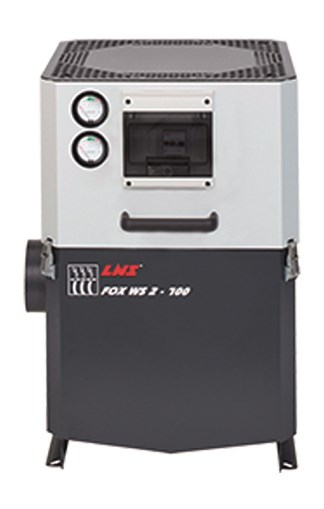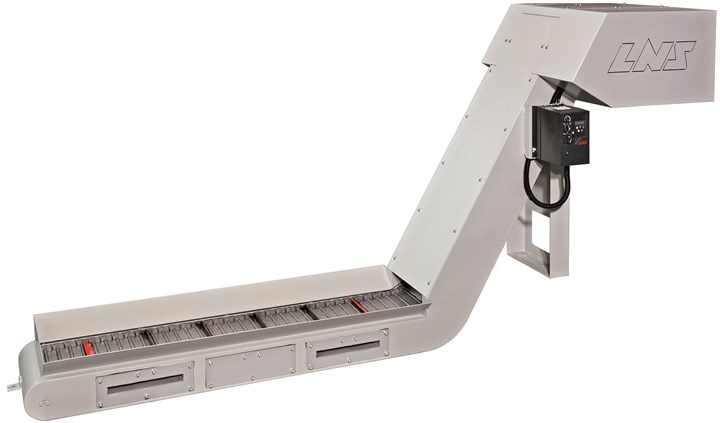Unattended Production Takes More Than the Most Capable CNC Machine
Process planning and reliable peripherals are key to successful lights-out manufacturing.
For many metalworking manufacturers unattended overnight production reduces cost-per-part, enabling them to better compete in a challenging global economy. Once only feasible for large, high-volume producers, today’s advances in technology, along with proper planning and implementation, allow virtually any CNC facility to enjoy the benefits of lights-out production.
For over 50 years, LNS has worked with manufacturers and machine tool OEMs to develop peripheral devices and applications expertise that enables faster, better and worry-free unattended production. Through this experience, the company has found that successful lights-out operation requires two essential elements: 1) well-thought-out advance planning and 2) reliable, well-supported equipment.
Let’s look at how these lessons can apply to different elements required for unattended and lights-out production:
Applications: The first step is selecting parts or a family of parts that lend themselves to unattended operations. If machining bar stock on a fixed or sliding head CNC machine, making parts from a single bar diameter lends itself to uninterrupted operation, as changeovers are not required, and bar feeders can be loaded with enough stock to turn out prescribed volumes of the same or mixed parts.
Materials: Optimizing tool wear starts by recognizing the impact of various materials. For example, aluminum or brass may yield 20,000 parts per cutting edge while hardened steel, such as heat-treated AISI 4140, may only yield about 500 parts per edge. Depending on the number of tool stations available, some modification of machining program spindle speeds or cutting techniques may be necessary to insure adequate availability of tools.
CNC Machine Tool: For lights-out production, the CNC machine itself must be highly reliable, be capable of running multiple part programs, have adequate automatic tooling stations, and be able to withstand continuous operation. Further, it should interact seamlessly with an automatic bar feeder, high-pressure coolant delivery system, and chip and coolant management systems.
Having a competent, reliable bar feeding system is necessary for lights-out production. Matching the bar feeder choice to your specific requirements is vital for unattended production.
Bar Feeding: When machining bar stock, a competent bar-feeding system is equally as important as a reliable CNC machine. Whether using a long bar or spindle-length bar feeder, lights-out production requires flawless loading of a range of bar types and diameters, exceptional vibration dampening and adequate support that enables precision machining at optimal spindle speeds. Above all, the bar feeder must be real-world proven reliable under the demands of continuous operation. LNS has installed more than 200,000 bar feeders world-wide. With 15 bar-feeder models that load bar stock diameters from less than 1 to 120 millimeters, LNS applications specialists can match the right bar feeder to your specific requirements.
Interconnectivity: If the goal is to run multiple part programs and maximize material usage, the CNC machine tool master scheduler must be able to communicate bilaterally with the automatic bar feeder. For example, the LNS e-Connect system enables the CNC machine to inform the bar feeder it is ready to change from one part program to another. The bar feeder then finds the new part program within its on-board Part Library and quickly accomplishes the program change.
For additional efficiency, the LNS bar feeder continuously tracks material usage, communicating this information to the CNC machine’s master schedule. Using these data, the machine tool compares the lengths of various scheduled parts to available material. If there is adequate material to complete the required part run, and the total quantity has not yet been produced, it does so. If not, it determines the length of the remnant and selects another part from the schedule that can be made using the remaining bar stock. When this cycle is completed, the master scheduler selects the next part program. Both the turning machine and bar feeder then make the appropriate adjustments, the bar feeder automatically loads a new bar, and production resumes.
Programmable LNS Chipblaster B-Series High Pressure Coolant Systems assist lights-out production by automatically adjusting coolant pressure and flow rate, keeping productivity optimized.
High-Pressure Coolant: In many applications, precise delivery of high-pressure coolant is critical to extending tool and coolant life while maintaining consistent spindle speeds and feed rates – all of which are essential for successful lights-out production. Moreover, running a variety of parts overnight may require coolant pressure and flow rate adjustments. In these cases, an LNS Chipblaster programmable high-pressure system is necessary for optimum productivity..
Monitoring coolant cleanliness when machining “dirty” materials is essential to keeping maintaining coolant quality and protecting equipment.
Coolant Filtration: Keeping machine coolant clean and maintaining its useful life is a challenge when lights-out machining “dirty” materials such as cast iron or cast aluminum. These types of materials require continuous coolant filtration to prevent particles from harming workpieces and CNC machines. Bag-type coolant filters that reach capacity with no one there to change the media can create major problems. A stand-alone LNS Chipblaster Cyclone filter, on the other hand, reliably filters coolant as low as 5 microns, continuously polishes the machine tool sump, and deposits particulates removed from coolant into a sludge settling tank. As a result, there are neither filter bag alarms nor interrupted production due to dirty coolant, and machine tool coolant tank cleanout time is cut in half.
Air filtration helps remove mist, aerosols and smoke that can affect both employee health and machine life.
Oil/Coolant Mist Collectors: Air filtration devices may not be top-of-mind when planning for lights-out production, however they not only benefit the health and safety of employees, but also reduce maintenance costs and extend turning machine life. Because oil/mist collectors remove mist, aerosols and smoke produced by the machining process, these harmful pollutants don’t find their way into HVAC systems, and coat walls, floors and fixtures where they pose a safety risk during human-attended work shifts and degrade machine tool performance. All four models of LNS Fox WS2 oil/coolant mist collectors exceed OSHA and NIOSH requirements to remove mist, smoke, and other fine aerosols and particulates.
Chip Management: An often overlooked and undervalued component of lights-out production is the humble chip conveyor. In fact, even if every other link in the production chain operates perfectly, an inadequate chip conveying system can halt overnight production through backups, cause premature tool wear from recutting chips, diminish part quality when recirculated chips mar surface finish, and allow chip fragments into the machine sump that can shorten coolant pump life.
Self-cleaning, filtering chip conveyors are effective for lights-out production because of their ability to reduce backups, preventing problems with chip buildup.
Although conventional hinge belt conveyors are adequate in many applications, self-cleaning, filtering chip conveyors are better suited to lights-out production because they eliminate the above concerns. Advanced LNS Turbo filtering chip conveyors efficiently process all chip sizes, types and materials, filter coolant as low as 50 microns, and serve a broad range of applications.
Monitoring: Even with a sound production plan and best-in-class equipment, problems can occur. Fortunately, LNS bar feeders monitor production and use a built-in web server to transmit trouble alerts. It also sends machine status data including Availability, Mode, Machine Status, Alarm State, Alarm ID and Alarm Description. In cooperation with major OEMs and input from end users, the LNS e-connect system and MTConnect provide connectivity for part programs and production schedules.
The system provides data such as part number, part diameter, part length, production volume and remaining parts. This information is helpful for analyzing results to improve production efficiencies.
Reliability and Support: Only LNS builds, sells, services and supports the peripherals your CNC machine needs for successful lights-out production. This single-source approach, in effect for over 50 years, is evidenced by world-wide installations of more than 200,000 bar feeders, 175,000 chip conveyors, 46,000 coolant systems, 22,000 air filtration systems, and 7,200 workholding systems.
More From LNS
All LNS products are backed by technical and applications professionals who serve customers around the world from facilities in Switzerland, North America, United Kingdom, Italy, Turkey, China, Taiwan, and Japan.
To learn more call: 513-528-5674 or email: allproducts-sales@LNS-northamerica.com.





